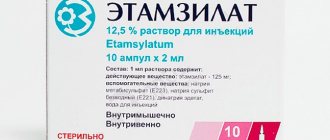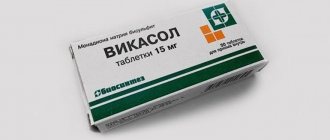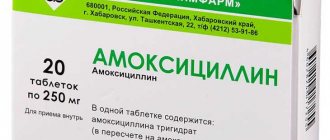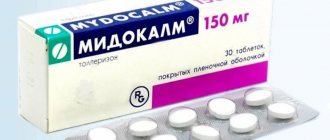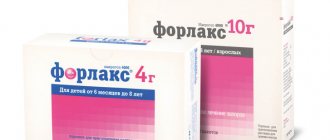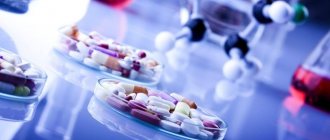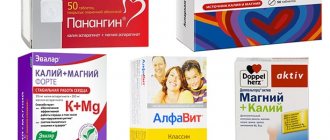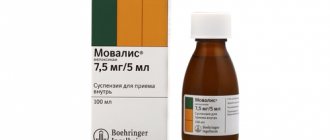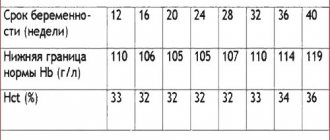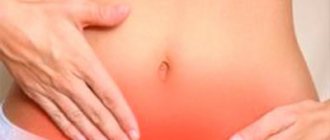Pharmacological properties
The instructions for use of Digoxin solution indicate that the drug has:
- vasodilator;
- inotropic;
- mild diuretic effect.
Pharmacodynamics and pharmacokinetics
The drug has a positive inotropic effect, helping to increase the intracellular content of sodium ions and decrease potassium ions. An increased concentration of sodium ions provokes activation of sodium-calcium metabolism and an increase in the level of calcium ions, which causes an increase in the force of myocardial contraction.
A consequence of an increase in myocardial contractility is an increase in stroke volume of blood.
When treated with the drug, the final systolic and diastolic volumes of the heart decrease, which causes a reduction in its size and a decrease in the myocardial oxygen demand. Due to increased sensitivity of the vagus nerve, it has a pronounced antiarrhythmic effect.
With atrial fibrillation, it helps to slow down the frequency of ventricular contractions, normalizes intracardiac and systemic hemodynamics.
The therapeutic effect is observed half an hour after intravenous administration of the solution. The active substance is able to penetrate the blood-brain barrier and the placenta. It can be metabolized in the liver.
The half-life of the drug from the body is 34-51 hours.
Mechanism of action of the drug
Digoxin is a herbal cardiac drug based on digitalis.
The above medicine increases the concentration of calcium in the cells, which leads to an increase in the force of contraction of the heart muscle. Improves the functioning of the myocardium, while helping to lengthen the period of relaxation of the heart and filling it with blood, and shortens the time of contraction of the ventricles. As a result, the force of pulsation increases, the size of the myocardium decreases, and as a result, the heart’s need for oxygen decreases. The drug reduces the activity of the sympathetic nervous system by increasing the sensitivity of cardiopulmonary interoreceptors.
Digoxin reduces heart rate because it reduces the automaticity of the sinoatrial node. The drug also helps to narrow blood vessels, reduce blood flow in them and reduce overall peripheral vascular resistance. Improves the process of air entering and removing air from the respiratory tract, normalizes the proper functioning of the kidneys, and also increases the volume of urine.
After intravenous injection, Digoxin enters the bloodstream and begins to act within 10 minutes after administration into the patient’s body. Maximum effectiveness is observed after 90 minutes. The drug is partially processed by the liver, completely excreted from the body through urine and in small quantities with feces one and a half days after use.
Contraindications
The instructions for the drug indicate that it is not allowed to use it if the body is hypersensitive to its constituent components. In addition, treatment is contraindicated if the patient has:
- 2nd degree atrioventricular block;
- transient complete blockade;
- glycoside intoxication.
The solution is contraindicated for women during pregnancy and breastfeeding.
Pregnancy and lactation
Cardiac glycosides (Digitoxin, instructions for use) can be used during pregnancy in case of heart failure and as a means of preventing arrhythmia in the mother or fetus.
During digoxin therapy, the mother can breastfeed her baby. Digoxin passes into breast milk in low concentrations. Concentrations in a child's blood are so low that they rarely cause long-term complications.
There is nothing negative about digoxin during pregnancy and lactation, but therapy should be monitored in the first months.
Directions for use and dosage
The drug is intended for intravenous administration and the dosage is determined depending on the age of the patient. The dosage of Digoxin solution intravenously or by drip reaches 0.25-0.5 g of the drug. The daily dose cannot exceed 1.25 mg.
In the first few days of therapy, the solution is administered several times a day. In the following days, the procedure is carried out once a day and over time they switch to maintenance treatment. For drip administration, dissolve 1-2 ml of 0.025% Digoxin ampoule in 100 ml of 5% isotonic solution.
Release form
The drug Digoxin is produced in the form of tablets, ampoules with a solution for intravenous administration:
- The tablets are white in color and have a flat cylindrical shape. On one side is the letter “D”. A contour package with cells contains 10 pieces each, and a cardboard pack contains from 1 to 5 such cells. 50 tablets can be in polymer or glass jars; they are sold in a cardboard pack in quantities of 1 or 2 pieces. The same thing happens with polypropylene pencil cases.
- The solution for intravenous administration is produced in 5 ampoules in contour packaging with cells, which are in a cardboard pack of 1 or 2 pieces.
Overdose
If the specified dosage is exceeded, sinus bradycardia, atrial tachycardia and ventricular fibrillation may develop. In addition, atrioventricular conduction and atrioventricular block may slow down.
In case of overdose, the following adverse reactions may occur:
- memory problems;
- dyspeptic disorders;
- constant drowsiness;
- muscle weakness;
- decreased vision;
- headache;
- psychosis;
- euphoria.
For mild symptoms, the dosage is usually simply reduced. If adverse reactions gradually increase, it is necessary to stop using the drug.
Warnings and Precautions
There are significant individual differences in sensitivity to glycosides. Patients with hypersensitivity to glycosides require lower doses of the drug and should be carefully monitored by a physician.
Basic precautions to consider before taking digoxin:
- In older patients, the drug has a stronger effect.
- The medicine should be prescribed in small doses for hypothyroidism, hypoxia and renal dysfunction.
- Low potassium levels or high calcium levels in the blood increase the risk of cardiac arrhythmia.
- The use of digoxin with antacids reduces its bioavailability.
- The medicine may affect the functioning of the brain and vision. Especially at the beginning of treatment, it is therefore necessary to stop driving.
Advice! Sometimes medications cause allergic reactions. If signs of an allergy occur, you should immediately inform your doctor or pharmacist.
Hypothyroidism
Drug interactions
When used simultaneously with antibiotics of the aminoglycoside group, a decrease in the level of digoxin in the blood plasma is possible.
When combining a solution with macrolides, there may be a significant increase in the level of the active substance in the blood plasma and an increase in the risk of glycoside intoxication.
Concomitant treatment with beta-blockers increases the likelihood of additive bradycardia.
Analogs
The product does not have full-fledged analogues that not only have a similar composition, but also have an identical effect. Doctors can replace Digoxin with a synonym drug that differs in components, but has a similar therapeutic effect. These include Celanide. This Russian drug is not available in ampoules; it is available only in tablet form. Instructions for use are recommended for the treatment of chronic heart failure and tachycardia. The active ingredient of the glycoside is lanatoside C. Novodigal was previously sold in pharmacy chains, but its registration expired. It is impossible to purchase it now.
Side effects and interactions with other medications
In the absence of knowledge about the effect of cardiac glycosides on one’s own body and incorrectly
The selected dosage may cause side effects. First of all, the cardiovascular and hematopoietic systems are included in pathological changes. Here there is a decrease in heart rate (bradycardia), the development of ventricular extrasystole (untimely contraction of the ventricles), atrioventricular block of the first, second and third degree, thrombocytopenia (decrease in the number of platelets in the blood), nosebleeds and pinpoint hemorrhages in the thickness of the skin (petechiae) .
When affecting the organs of the digestive tract, nausea, vomiting, which cannot alleviate the person’s condition, diarrhea, pain in the abdominal area and complete refusal of food (anorexia) are observed.
On the part of the nervous system, the patient is concerned about dizziness, headaches, changes in sleep patterns, that is, possible insomnia or increased drowsiness, delirium, hallucinations, blurred vision, weakness, depression.
An allergic reaction often develops in the form of a rash, urticaria, Quincke's edema and anaphylactic shock.
The combination of other medications and Digoxin can lead to a decrease or increase in the effects of the cardiac glycoside. It has been proven that adrenergic receptor agonists increase the risk of developing cardiac arrhythmias, Chlorpromazine weakens the cardiotonic effect, and Rifampicin accelerates the breakdown of the drug into metabolites. Steroidal anti-inflammatory drugs, saluretics, and drugs with a high calcium content can lead to glycoside poisoning.
Analogs, trade names and price
If the body rejects digoxin, drugs that are similar in effectiveness are selected. The one that is closest in effect and composition is called digitoxin. This is also a glycoside from digitalis, in this case purple, and is available in the form of tablets that contain 0.1 mg of digitoxin. Packages contain from 10 to 40 pieces. Used for chronic heart failure. It contains 0.25 mg of digoxin, from excipients: glycerin, ethanol, citric acid.
Digitoxin is much more effective than other drugs containing digitalis, since it is well and quickly absorbed into the blood and does not cause irritation. But it is dangerous due to side effects, so it is not recommended to take it on your own; the dosage should only be selected by a doctor, and strictly individually.
Compatibility with other drugs
When digoxin is co-administered with drugs that cause electrolyte imbalance, in particular hypokalemia (for example, diuretics, glucocorticosteroids, insulin, beta-agonists, amphotericin B), the risk of arrhythmia and the development of other toxic effects of digoxin increases. Hypercalcemia can also lead to the development of toxic effects of digoxin, so intravenous administration of calcium salts should be avoided in patients taking digoxin. In these cases, the dose of digoxin must be reduced. Some drugs may increase serum digoxin concentrations, such as quinidine, calcium channel blockers (especially verapamil), amiodarone, spironolactone, and triamterene. Absorption of digoxin in the intestine can be reduced by the action of cholestyramine, colestipol, aluminum-containing antacids, neomycin, and tetracyclines. There is evidence that the concomitant use of spironolactone not only changes the concentration of digoxin in the blood serum, but also may affect the results of the method for determining the concentration of digoxin, therefore special care is required when assessing the results obtained. Decreased bioavailability: activated carbon, astringent drugs, kaolin, sulfasalazine, (binding in the gastrointestinal tract) metoclopramide, proserin (increased gastrointestinal motility). Increased bioavailability: broad-spectrum antibiotics that suppress intestinal microflora (reduce destruction in the gastrointestinal tract). Beta-blockers and verapamil increase the severity of the negative chronotropic effect and reduce the strength of the inotropic effect. Inducers of microsomal oxidation (barbiturates, phenylbutazone, phenytoin, rifampicin, antiepileptics, oral contraceptives) can stimulate digitoxin metabolism (if they are discontinued, digitalis intoxication is possible). When used simultaneously with digoxin, the following drugs may interact, as a result of which the therapeutic effect is reduced or the side or toxic effect of digoxin appears: mineralocorticosteroids, glucocorticosteroids with significant mineralocorticosteroid effects amphotericin B for injection carbonic anhydrase inhibitors adrenocorticotropic hormone (ACTH) diuretics that promote excretion water and potassium (bumetadine, ethacrynic acid, furosemide, indapamide, mannitol and thiazide derivatives) sodium phosphate. Hypokalemia caused by these drugs increases the risk of toxic effects of digoxin, therefore, when used simultaneously with digoxin, constant monitoring of potassium concentration in the blood is required. - St. John's wort preparations (their interaction with digoxin induces P-glycoprotein and cytochrome P450, i.e. it reduces bioavailability, increases metabolism and significantly reduces the concentration of digoxin in plasma). - Amiodarone (increases the concentration of digoxin in the blood plasma to a toxic level). The interaction of amiodarone and digoxin inhibits the activity of the sinus and atrioventricular nodes of the heart and the conduction of nerve impulses through the conduction system of the heart. Therefore, after prescribing amiodarone, digoxin is canceled or its dose is reduced by half - Preparations of aluminum salts, magnesium and other antacids can reduce the absorption of digoxin and reduce its concentration in the blood - Simultaneous use with digoxin: antiarrhythmic drugs, calcium salts, pancuronium, rauwolfia alkaloids, succinylcholine and sympathomimetics can provoke the development of heart rhythm disturbances, therefore in these cases it is necessary to monitor cardiac activity and the patient’s ECG - Kaolin, pectin and other adsorbents, cholestyramine, colestipol, laxatives, neomycin and sulfosalazine reduce the absorption of digoxin and thereby reduce its therapeutic effect - Blockers of “slow” calcium channels, captopril - increase the concentration of digoxin in the blood plasma, therefore, when using them together, it is necessary to reduce the dose of digoxin so that the toxic effect of the drug does not manifest itself - Edrophonium (an anticholinesterase drug) - increases the tone of the parasympathetic nervous system, so its interaction with digoxin can cause severe bradycardia - Erythromycin &mdash its effect improves the absorption of digoxin in the intestine - Heparin - digoxin reduces the anticoagulant effect of heparin, so the dose has to be increased - Indomethacin reduces the release of digoxin, so the risk of toxic effects of the drug increases - Magnesium sulfate solution for injection is used to reduce toxic effects of cardiac glycosides - Phenylbutazone - reduces the concentration of digoxin in the blood serum - Potassium salt preparations, they should not be taken if conduction disturbances on the ECG appear under the influence of digoxin. However, potassium salts are often prescribed together with digitalis preparations to prevent cardiac arrhythmias - Quinidine and quinine - these drugs can sharply increase the concentration of digoxin - Spironolactone - reduces the rate of excretion of digoxin, so it is necessary to adjust the dosage of the drug when used together - Thalia chloride (TL 201) - when studying myocardial perfusion with thalium preparations, digoxin reduces the degree of thalium accumulation in areas of damage to the heart muscle and distorts the study data - Thyroid hormones - when they are prescribed, metabolism increases, so the dose of digoxin should definitely be increased.
The most effective remedies for tachycardia
Our readers successfully use ReCardio to treat hypertension.
Seeing how popular this product is, we decided to bring it to your attention. More details here... The term tachycardia refers to any type of increase in heart rate above 100 per minute. The source of excitation for this arrhythmia may be in a typical place (sinus node) or move to the atrium and ventricle. It can manifest itself as a feeling of pulsation, interruptions, tremors in the chest, as well as weakness and dizziness. Tachycardia can be physiological, which occurs during physical or emotional stress, or is the first symptom of a disease.
Drug therapy
It is not always easy to find effective medications for the treatment of tachycardia. This is due to the variety of reasons why it occurs.
In the case of sinus tachycardia, which is a manifestation of anemia, hormonal disorders, low blood pressure or dehydration, it is advisable to direct all efforts to treat the underlying disease or eliminate provoking factors:
- eliminate caffeine, alcohol and smoking;
- protect yourself from excessive physical and psycho-emotional stress;
- start psychotherapeutic sessions for the neurogenic nature of the arrhythmia;
- Iron supplements will help with anemia, and fluid replenishment will help with dehydration;
- in case of an adrenal tumor (pheochromocytoma), which produces stress hormones, it must be removed;
- for thyrotoxicosis, tablets are prescribed that destroy thyroid tissue;
- taking vitamins and microelements (magnesium, calcium, potassium) if they are deficient.
If arrhythmia is an independent pathology associated with structural changes in the conduction system of the heart, then the following classes of drugs can be used:
- Beta blockers (concor, egilok, atenolol) reduce the stimulating effect of stress hormones. They help best with sinus tachycardia and the presence of additional conduction pathways.
- Sodium channel blockers (rhythmonorm, allapinin) can be prescribed for extrasystole.
- Cardiac glycosides (digoxin) are most often used for tachycardia due to heart failure.
- Potassium channel blockers (cordarone, sotahexal) are used for atrial fibrillation.
- It makes sense to prescribe sedative (calming) drugs for severe sinus tachycardia caused by excessive emotionality.
- Antioxidants and medications that improve coronary blood supply (Preductal, Mexicor) are a good addition to standard therapy.
Medicines come in tablets for home use and in ampoules for intravenous administration in a hospital setting.
To relieve an attack of nodal arrhythmia, which occurs suddenly and is associated with the presence of an additional conduction bundle, vagal tests are often effective:
- holding your breath;
- exhale with a closed glottis;
- cough;
- induced vomiting;
- washing with very cold water;
- massage of the carotid sinus located in the neck;
- pressing on the eyeballs.
The last two manipulations can only be performed by a doctor, while all the others are recommended for self-relief from an attack. During these tests, the vagus nerve is stimulated and the conduction of impulses along the nerve fibers of the heart slows down.
Surgery
Surgery is resorted to when drug treatment for tachycardia is ineffective. Before using the surgical method, an electrophysiological study is usually performed, which helps determine the source of the arrhythmia. Using a catheter, the sensor is brought to various parts of the myocardium and stimulated. In this way, the areas in which the centers of origin of the neuromuscular impulse are located are identified.
Radiofrequency ablation is performed using a special flexible tube that is inserted through a puncture in the vessel. Then the tip is brought to the heart cavity in the area that is the source of pathological excitation, and the nerve fibers are cauterized. This treatment method is especially effective for atrial fibrillation.
For frequent ventricular tachycardias, which are accompanied by loss of consciousness, the patient is advised to install a cardioverter-defibrillator. This miniature device is placed in the left subclavian region, and the wires reach the myocardium. When an arrhythmia develops, a discharge is generated that restarts the heart. Using special computers, the device can be programmed for any current value. Typically, this device also has the function of an electrical pacemaker, which, when the heart stops, takes on the role of the conduction system and causes it to contract.
ethnoscience
Traditional medicine does not lag behind traditional methods of treating heart rhythm disturbances. These recipes are usually created to treat physiological tachycardia:
- Infuse lemon balm leaves in vodka for 10 days. Take 5 ml four times a day, after dissolving in water.
- Pour boiling water over valerian root and calendula flowers. Drink 100 ml 4 times a day.
- Mix hawthorn, rose hips and motherwort in equal proportions. Use one spoon at a time when brewing tea.
The diet of a person with attacks of arrhythmia should contain foods containing trace elements and vitamins that are beneficial for the heart. These include fruits and vegetables, herbs and nuts. Honey is very useful for the myocardium, which does not need to be dissolved in warm liquid, but preferably eaten cold. This allows you to preserve more valuable qualities.
The use of folk remedies is not always justified; they are recommended to be used only after consulting a cardiologist.
Tachycardias are a very large group of heart diseases, combining all arrhythmias manifested by rapid heartbeat. Very often it can be a manifestation of pathology of other organs and systems. Due to such a wide variety of causes of this disease, there are a huge number of drugs to treat it. That is why, when the first symptoms of arrhythmia occur, it is necessary to contact a cardiologist, who only after an examination will be able to clarify which medicine to take.
Read also: Cardiac arrhythmia symptoms treatment medications
Should I be afraid of sinus arrhythmia during pregnancy?
Guest — July 25, 2019 — 15:25
Ivan - December 2, 2019 - 17:31
Elena - February 16, 2019 - 13:23
Faina is 70 years old - February 1, 2019 - 09:05
Elena - May 19, 2019 - 09:42
- answer
- Treatment of joints
- Weight loss
- Varicose veins
- Nail fungus
- Fighting wrinkles
- High blood pressure (hypertension)
Treatment
Initially, you need to call an ambulance. Further actions are effective only when the victim has taken the medicine orally and is conscious. Gastric lavage must be done within the next hour after taking a high dose of medication; for this, a solution of soda or potassium permanganate is given to drink and a gag reflex is induced by pressing on the root of the tongue. Then the patient must drink the sorbent and drink a large amount of liquid until the specialists arrive.
Medical care is provided in a hospital setting, therapy includes drugs that restore heart rhythm, normalize water and electrolyte balance and promote kidney function. Regular monitoring of the victim’s well-being is required; for this, regular electrocardiogram monitoring is carried out.
If necessary, a specific antidote is administered - digoxin-binding antibodies. Also read about the symptoms of an overdose of Asparkam and whether it can be fatal.
Patient reviews
I have been taking Digoxin for almost a year at a dose of 0.5 tablets three times a day. Every 5 days I take a break for 2 days. At the beginning of treatment, she suffered from nausea, poor sleep and excessive sweating. With the help of medication I can cope with coronary artery disease and arrhythmia. But recently I heard that Digoxin should not be taken for more than three months, otherwise it will begin to spoil your health. I want to ask the doctor to find another medicine.
Evgenia Petrovna, pensioner
My grandmother was prescribed to take Digoxin one tablet a day. Three days later she began to complain of hallucinations and insomnia. The instructions say that older people need to drink 0.5 tablets maximum. But even this dose still provoked side effects. As a result, the doctor advised her to take 0.25 tablets every 2 days. The side effect has gone away and my health has improved.
Maxim, programmer
special instructions
The patient should be monitored throughout treatment with Digoxin to avoid side effects resulting from an overdose. Patients receiving digitalis preparations should not be prescribed calcium preparations for parenteral administration. The dose of Digoxin should be reduced in patients with chronic cor pulmonale, coronary insufficiency, fluid and electrolyte imbalance, renal or liver failure: Elderly patients also require careful dose selection, especially if they have one or more of the above conditions. It should be taken into account that in these patients, even with impaired renal function, creatinine clearance (CC) values may be within normal limits, which is associated with a decrease in muscle mass and a decrease in creatinine synthesis. Since pharmacokinetic processes are disrupted in renal failure, dose selection should be carried out under the control of the concentration of digoxin in the blood serum. If this is not feasible, then you can use the following recommendations. In general, the dose should be reduced by approximately the same percentage as the creatinine clearance is reduced. If QC has not been determined, then it can be approximately calculated based on the serum creatinine concentration (CCC). For men according to the formula (age 140): KKS. For women, the result should be multiplied by 0.85. In severe renal failure, serum digoxin concentrations should be determined every 2 weeks, at least during the initial period of treatment. In idiopathic subaortic stenosis (obstruction of the left ventricular outflow tract by an asymmetrically hypertrophied interventricular septum), the administration of digoxin leads to an increase in the severity of obstruction. With severe mitral stenosis and normo- or bradycardia, heart failure develops due to a decrease in diastolic filling of the left ventricle. Digoxin, increasing the contractility of the right ventricular myocardium, causes a further increase in pressure in the pulmonary artery system, which can provoke pulmonary edema or aggravate left ventricular failure. For patients with mitral stenosis, cardiac glycosides are prescribed when right ventricular failure occurs or in the presence of atrial fibrillation. In patients with second-degree AV block, the administration of cardiac glycosides can aggravate it and lead to the development of a Morgagni-Adams-Stokes attack. The prescription of cardiac glycosides for stage I AV block requires caution, frequent ECG monitoring, and in some cases, pharmacological prophylaxis with agents that improve AV conduction. Digoxin in Wolff-Parkinson-White syndrome, by slowing down AV conduction, promotes the conduction of impulses through accessory pathways, bypassing the AV node and, thereby, provokes the development of paroxysmal tachycardia. The likelihood of glycoside intoxication increases with hypokalemia, hypomagnesemia, hypercalcemia, hypernatremia, hypothyroidism, severe dilatation of the heart cavities, “pulmonary” heart, myocarditis and in the elderly. As one of the methods for monitoring the digitalization content when prescribing cardiac glycosides, monitoring their plasma concentration is used.
Cross-sensitivity Allergic reactions to digoxin and other digitalis drugs are rare. If hypersensitivity occurs to any one digitalis drug, other representatives of this group can be used, since cross-sensitivity to digitalis drugs is not typical
The patient must strictly follow the following instructions: 1 Use the drug only as prescribed, do not change the dose yourself 2 Use the drug every day only at the appointed time 3 If the heart rate is below 60 beats per minute, you should immediately consult a doctor 4 If you miss the next dose of the drug, it must be taken as soon as possible 5 The dose cannot be increased or doubled 6 If the patient has not taken the drug for more than 2 days, the doctor must be informed about this. Before stopping the use of the drug, you must inform your doctor about this. If vomiting, nausea, diarrhea, or rapid pulse occur, you should immediately consult a doctor. Before surgery or emergency care, you should be warned about the use of digoxin. It is not advisable to use other medications without a doctor's permission.
Indications
Digoxin is prescribed only on the recommendation of a cardiologist; the main indications for its use are:
- chronic cardiovascular failure;
- atrial fibrillation;
- paroxysmal supraventricular tachycardia.
During pregnancy, digoxin can be prescribed, but only after examining the mother's condition, since this drug penetrates the placenta. When breastfeeding, small doses are prescribed, and in parallel with the intake, the baby’s heart rate is monitored.
Application in homeopathy
Large dosages of Digitalis lead to the development of asystole. This is its property and is used by homeopaths. The basic principle of “treating like with like” applies.
A drug that can provoke the development of asystole is also capable of curing it.
During the period of homeopathic treatment, asystole manifests itself in several phases:
- First. The pulse slows down.
- Second. The pulse accelerates.
- Third. The slowing of the pulse alternates with subsequent acceleration.
This effect on the human body is healing. First, a partial effect occurs, which is replaced by a toxic one.
- The therapeutic effect is on vascular structures, liver and kidneys.
- Arteries and capillaries contract only when recommended dosages are exceeded.
- There is an elimination of swelling and normalization of the functioning of the water-alkaline balance in the body.
- Immediately after administration, there is a decrease and even almost complete cessation of diuresis. Even the urge to urinate resumes and becomes very frequent, disrupting night sleep and exhausting the person.
- A long course of treatment leads to the development of vomiting, loss of appetite, constipation and arrhythmia.
- The patient may experience delirium.
Symptoms that often arise are mistaken for tuberculous meningitis.
First aid for intoxication
As with many poisonings, the first thing the victim needs is gastric lavage. It is necessary to remove the remaining glycosides that have not yet entered the blood. After determining the cause of intoxication and calling an emergency ambulance, you need to take the necessary measures:
To provoke vomiting and clear the stomach of its contents, the patient is given 2-3 glasses of warm water, preferably slightly salted, to drink. If possible, flush the gastrointestinal tract with activated charcoal or other similar drugs.
In case of overdose of the injection form, an antidote must be administered. To do this, you can consult with the ambulance dispatcher while it is on the way. Atropine or its analogue can be used as an antidote, which will bind digoxin.
Why does Digoxin poisoning happen?
To achieve an optimal therapeutic effect, it is necessary to use a certain dose of the drug. Its concentration in the bloodstream directly depends on the absorption of the active substance. If the processes of absorption and excretion of this drug are disrupted, then the person develops intoxication.
Factors in the development of poisoning include:
- violation of the functional activity of the liver;
- taking a high dose of Digoxin;
- old age of the patient;
- renal failure (acute and chronic forms);
- increased production of biologically active steroid substances by the adrenal glands;
- use of drugs to treat arrhythmia.
Digoxin is prescribed only if absolutely necessary. People who are prone to suicide are also at risk: the lethal dose for a person can be just a few tablets. Digoxin is found in yellow oleander, scallion and foxglove. Improper use of drugs based on such drugs is one of the causes of poisoning.
Older people need to control the time and dose of this medicine so as not to accidentally provoke a life-threatening overdose.
Can it be prescribed for atrial fibrillation?
One of the properties of Digoxin is the selective ability to block weak impulses that come from the atria to the ventricles. The drug also has an inhibitory effect on the tone of the sympathetic nervous system. Thanks to this, it has the following actions:
- the frequency of contractions of the muscle fibers of the ventricles of the heart slows down;
- pulse normalizes;
- diastole (pause between contractions) becomes longer;
- blood circulation inside the heart and in the vascular system is restored;
- the load on the myocardium is reduced.
Read also: Arrhythmia, rapid pulse
Therefore, this drug is prescribed for tachyarrhythmic form of atrial fibrillation or flutter. Digoxin can be used to stabilize the rhythm during an attack of atrial fibrillation and to treat the chronic (permanent) form. Most effective in the presence of signs of cardiac failure.
Watch the video about cardiac arrhythmia:
Clinical data
Researchers at Yale University examined data from various studies to see if digoxin affects men and women differently. This study examined digoxin, which has been used for centuries to treat heart disease. Until now, scientists believed that digoxin reduced mortality and led to a reduction in the number of hospitalizations.
Researcher Dr. Harlan Krumholtz said they evaluated women who took digoxin and placebo pills. The researchers then concluded that digoxin increased the risk of death in women by 23 percent. There were no differences in mortality rates among men in the study.
